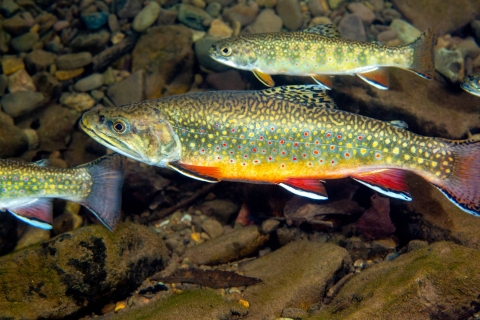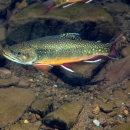Featured Species
Brook Trout (Salvelinus fontinalis)
The brook trout are members of the char family. Brook trout prefer small spring fed streams and ponds with sand or gravel bottom and vegetation. This species prefers to spawn over gravel in either streams or lakes, with ground water percolation or in the spring fed areas in lakes.
Pre-spawning courtship of the brook trout begins with the male attempting to drive a female toward suitable gravel habitat to facilitate spawning. A receptive female chooses a spot and digs a redd. While the female brook trout is digging, the male brook trout continues his courtship activity, darting alongside the female and quivering, swimming over and under her and rubbing the female with his fins. The male spends a great deal of time driving off other males during this process. After spawning, the female brook trout covers the eggs by sweeping small pebbles at the downstream edge of the redd upstream. Once the eggs are covered, the female moves upstream to the end of the redd and then begins digging a new redd.
Brook trout normally mature in two years but may spawn after one year. These fish spawn between September and October. Brook trout fry will emerge sometime between February and April. Young brook trout normally seek shelter in submerged aquatic vegetation or shallow water near the shoreline.
Conservation
Brook trout are the focus of a large scale restoration partnership known as the Eastern Brook Trout Joint Venture. The abundance of brook trout throughout their native range of the upper Midwest and Northeast has been reduced due to the loss of cold water habitat, largely due to land use.
The introduced of non-native trout and salmon compete for spawning and nursery habitat with brook trout.
Migration Behavior
Brook trout are a migratory species. Some of these fish spend their entire lives in freshwater and others called salters are born in freshwater and then migrate to the ocean for their adult lives and return to freshwater to reproduce.
American Shad (Alosa sapidissima)
American shad is an anadromous species indigenous to the western Atlantic Ocean and the east coast of Canada and the United States. American shad are broadcast spawners and spawn multiple times. As adults, they inhabit the Atlantic Ocean and then migrate into the east coast rivers of Canada and the United States to spawn.
Adult American shad enter to rivers to spawn as early as November in Florida and as late as May or June in northern waters depending on water temperatures. The peak spawning temperatures for American shad is 18.5 degrees Celsius (65.3 degrees Fahrenheit). Spawning normally occurs at sundown and continues until after midnight.
Spawning behavior includes a pairing of the male and female fish, which is followed by the pair swimming close together and releasing their eggs and milt simultaneously. Adult American shad normally descend from these tributaries shortly after spawning.
After hatching, the young American shad will descend from their natal streams in the fall. Juvenile American shad, upon reaching lengths of 20 to 30 mm will begin to form schools for their downstream migration
Conservation
The American shad is protected under the Anadromous Fish Conservation Act and restoration efforts are underway from Maine to Virginia. The restoration of American shad in eastern Atlantic rivers is a cooperative effort between the U.S. Fish and Wildlife Service, other Federal agencies, State fish and wildlife Agencies located within the watershed, non-governmental organizations and the fishing industry. Management practices facilitating this restoration process include conservation stocking and habitat restoration, especially as well as the removal of stream and river barriers and the building fish of passage facilities.





